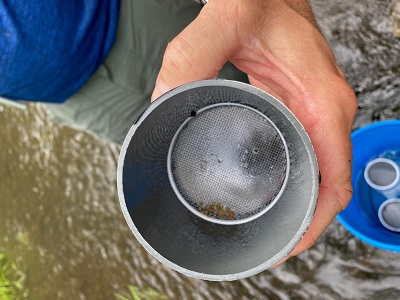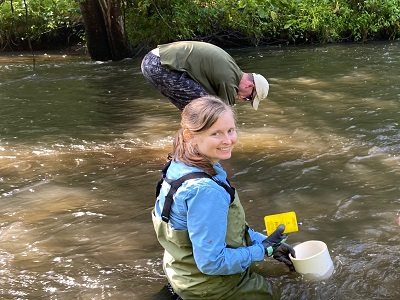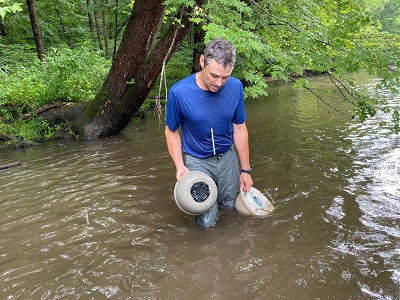Hundreds of tiny young plain pocketbook (Lampsilis cardium) mussels, each no bigger than a clump of several grains of sand, are spending the summer and fall housed in underwater concrete silos in 13 streams across Western Pennsylvania. The mussels’ survival rate and growth will help researchers assess which streams are candidates for restocking freshwater mussels. As filter feeders, mussels enhance water quality. They also contribute to biodiversity and large groups can stabilize stream bottoms.
spending the summer and fall housed in underwater concrete silos in 13 streams across Western Pennsylvania. The mussels’ survival rate and growth will help researchers assess which streams are candidates for restocking freshwater mussels. As filter feeders, mussels enhance water quality. They also contribute to biodiversity and large groups can stabilize stream bottoms.
The silos are concrete bowls fitted with small sections of PVC pipe and mesh, which safely house the mussels while allowing water to flow over them. The silos are placed at strategic spots in streams, where the weight of the concrete holds them in place and where researchers can easily check on the mussels. At the study’s completion, researchers will remove the silos from the stream.
Mary Walsh, aquatic zoology coordinator for the Conservancy’s natural heritage program and photographed smiling on the left, says, “We’re trying to figure out where we can restock mussels. We chose silo locations where there are no longer mussels, and places where they’re still there but doing poorly and could be targets for restocking,” she says. “We’ll compare those to sites where mussels are doing well, and see if we find a difference in how they grow. We suspect that in the streams with good water quality and food resources the mussels will grow well.”
The unique mussel silo study, which Mary says is the first foray into this important work in Pennsylvania, is a partnership with the U.S. Forest Service, which contacted the Conservancy about joining forces. “They wanted to put silos in Pennsylvania streams and we’d gotten funding to do just that,” Mary explains. The USFS is also researching the sediment and water quality in the study streams.
The Conservancy and USFS conducted research and placed the silos in Kiskimenetas River, Dunkard Creek, Ten Mile Creek, Mahoning River, Beaver River, Shenango River, Sandy Creek, French Creek, Tionesta Creek, Clarion River, Allegheny River, Little Mahoning Creek and Mahoning Creek. The project is funded by grants from the Pennsylvania Department of Conservation and Natural Resources and Wild Resources Conservation Program.
A third partner, the Pennsylvania Fish and Boat Commission, with which the Conservancy frequently partners on mussel projects, is also seeking information on stream health. “They’re starting a mussel hatchery with the purpose of growing mussels to be stocked in streams,” Mary explains. “We need to know where it makes sense to stock them.”
The Conservancy’s role is to assess the water quality of several streams through various measures and also to place the mussels in the water in “silos,” where hopefully they will thrive. Staff will revisit the mussels throughout the summer and fall to track their growth and health. If all goes well, the Conservancy and PFBC could introduce tens of thousands of mussels to several of the region’s waterways.
###
About the Western Pennsylvania Conservancy:
The Western Pennsylvania Conservancy (WPC) enhances the region by protecting and restoring exceptional places. A private nonprofit conservation organization founded in 1932, WPC has helped to establish 11 state parks, conserved more than a quarter million acres of natural lands and protected or restored more than 3,000 miles of rivers and streams. The Conservancy owns and operates Frank Lloyd Wright’s Fallingwater, which is now on the UNESCO World Heritage List and symbolizes people living in harmony with nature. In addition, WPC enriches our region’s cities and towns through 132 community gardens and other green spaces that are planted with the help of more than 3,000 volunteers. The work of the Western Pennsylvania Conservancy is accomplished through the support of more than 9,000 members. For more information, visit WaterLandLife.org or Fallingwater.org.
